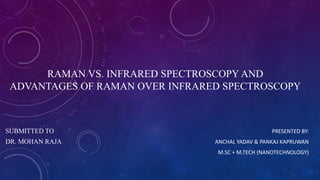
Raman vs. IR spectroscopy: Comparing techniques for molecular analysis
- 1. RAMAN VS. INFRARED SPECTROSCOPY AND ADVANTAGES OF RAMAN OVER INFRARED SPECTROSCOPY PRESENTED BY: ANCHAL YADAV & PANKAJ KAPRUWAN M.SC + M.TECH (NANOTECHNOLOGY) SUBMITTED TO DR. MOHAN RAJA
- 2. RAMAN SPECTROSCOPY Raman Spectroscopy is a spectroscopy technique used to observe vibrational, rotational and other low frequency modes in a system. It relies on inelastic scattering or Raman scattering, of monochromatic light, usually from the laser in the visible, near infrared or near ultraviolet range. The laser light interacts with molecular vibrations, phonons or other excitations in the system, resulting in the energy of the laser photons being shifted up or down. The shift in energy gives information about the vibrational modes in the system
- 3. ENERGY-LEVEL DIAGRAM SHOWING THE STATES INVOLVED IN RAMAN SIGNAL.
- 4. INFRARED SPECTROSCOPY Infrared Spectroscopy is the spectroscopy that deals with the infrared region of the electromagnetic spectrum. It is the result of absorption of light by vibrating molecules as compared to Raman in which there is scattering of light by the vibrating molecules.
- 5. RAMAN VS. I.R. Both are vibrational spectroscopy IR and Raman are the most common vibrational spectroscopies for assessing molecular motion and fingerprinting species Based on inelastic scattering of a monochromatic excitation source Routine energy range: 200 - 4000 cm–1.
- 6. The main difference between the two techniques lies in the nature of the molecular transitions taking place. For a transition to be Raman active there must be a change in the polarizability of the molecule during the vibration. This means that the electron cloud of the molecule must undergo positional change. On the other hand, for an IR detectable transition, the molecule must undergo dipole moment change during vibration. So, when a molecule is symmetrical, e.g. O2, we cannot observe any IR absorption lines, since the molecule cannot change its dipole moment. It has been observed that molecules with a strong dipole moment are typically hard to polarize.
- 7. Regarding the excitation wavelength, the Raman technique uses a monochromatic beam or laser, in the visible, near-infrared, or near ultraviolet range of the electromagnetic spectrum. In IR spectroscopy, a monochromatic beam is used in the infrared region of the electromagnetic spectrum. Another difference can be observed in the resulting spectra. The IR technique shows irregular absorbance (or transmittance) lines, depending on the material investigated. The Raman spectrum mainly comprises the elastic scattered light line (Rayleigh) and two equally distanced lines Stokes and anti-Stokes.
- 8. Finally, the Raman technique requires high-stability laser sources and sensitive amplification equipment to detect the weak signal. This makes Raman instruments more expensive compared to the IR equipment. However, the new advances in technology have altered this to some degree.
- 9. MUTUAL EXCLUSION PRINCIPLE • In a molecule with a center of symmetry it is seen that vibrations that are Raman active are IR inactive and vice-versa, this is called the Principle of mutual exclusion. In molecules with different elements of symmetry, certain bands may be active in IR, Raman, both or neither. For a complex molecule that has no symmetry except identity element, all of the normal modes are active in both IR and Raman. • In general the strong bands in the IR spectrum of a compound corresponds to weak bands in the Raman and vice versa. Mutual exclusion principle as seen in CO2
- 10. INFRARED AND RAMAN SPECTRA OF A , FREE CO2 MOLECULE
- 11. ADVANTAGES: Can be used with solids and liquids. It is possible to obtain Raman spectra of gases. However, since the concentration of molecules in gases is generally very low, this typically requires special equipment, such as long path length cells. No sample preparation is needed as compared to I.R. in which sample preparation is elaborate. An important advantage of Raman spectra over infrared lies in the fact that water does not cause interference, indeed, Raman spectra can be obtained from aqueous solutions.
- 12. Water can be used as a solvent. Very suitable for biological samples in native state (because water can be used as solvent). Glass or quartz cell can be employed, thus avoiding the inconvenience of working with sodium chloride or other atmospherically unstable window materials. Non- Destructive Technique.
- 13. Can give results in a friction of seconds. Basically, it depends on the sample. The incest figure shows a spectrum of a paracetamol tablet taken in just one second.
- 14. THANK YOU